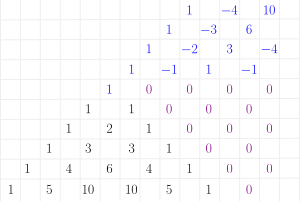Pascal's Triangle: Difference between revisions
From wikiluntti
| Line 32: | Line 32: | ||
This can be extended to negative numbers easily. | This can be extended to negative numbers easily. | ||
[[File:Pascaltriangle NegativeValues.svg|thumb|Pascal triangle extended to negative values]] | |||
Now, instead of expanding <math>(a+b)^n</math>, we will use <math>(1+x)^n</math>, where <math>n</math> is a negative integer. We get according to the Pascal triangle | |||
<math> | |||
\begin{align} | |||
(1+x)^{-1} = 1 - x + x^2 - x^3 + \cdots | |||
\\ | |||
\end{align} | |||
</math> | |||
Revision as of 19:03, 19 October 2022
Introduction
Binomial expansion
Pascal's triangle

The coefficients of binomial expansion can be easily seen from the Pascal triangle. The number is a sum of the two numbers above it.
Pascal's triangle: Negative 1
This can be extended to negative numbers easily.

Now, instead of expanding , we will use , where is a negative integer. We get according to the Pascal triangle




